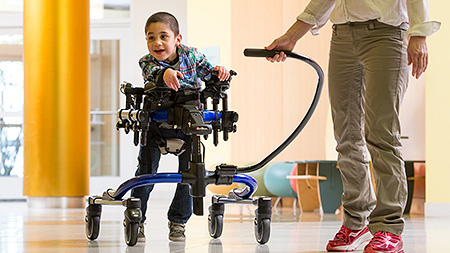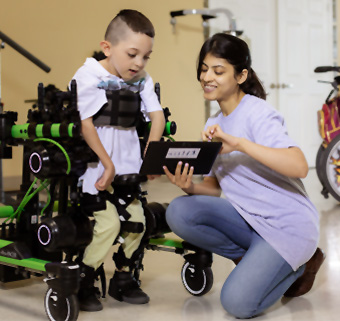Six Features of Rifton’s Pacer
| November 2015The 1980’s, a tumultuous decade by any measure, was also the period we first introduced the Rifton gait trainer. Aside from its original purpose—to provide a means of upright mobility for individuals with severe disabilities—much about the product has changed, largely as a result of the steady, rich flow of design feedback we get from therapists around the world.

And that change continues. The new Pacer is Rifton’s latest model of gait trainer, and it’s packed with new features and functions, making it a leap forward in gait trainer design. Let’s take a look at these new features.
1. A two-piece modular frame. In place of a singular collapsible frame, the new Pacer now comes in two pieces—a base frame and an upper frame. There are three bases to choose from—standard, utility and treadmill; and two upper frames—standard and dynamic.
Separating the base from the upper frame expands gait training options by allowing therapists to configure a gait trainer that works best for any given environment, therapy session or client. It also allows purchasers to select a single upper frame best suited for the client and pair it with multiple bases, saving significant costs.
2. Dynamic mobility. Gait analysis indicates the body moves both vertically and laterally during step taking and weight-shifting. The dynamic upper frame of this new Pacer accommodates these natural shifts of the body by

providing two inches of lateral movement and three inches of vertical to create a much more natural gait pattern and frees the pelvis from the restraint associated with older models.
3. Single-column gas-assist height adjustment. Previous models of Pacers used a two-handed manual adjust system to bring the Pacer to the appropriate height. It was very difficult to adjust the height with the client in the unit. But with the new Pacer, it takes only one hand to operate the telescoping column, and height can be locked at any point in the vertical stroke, not just at one-inch increments. And the column is indexed for charting purposes so that aides can quickly replicate the specific adjustments for each particular client.

Because the height adjustment column is located in the front, this also gives the therapist better side access to the lower extremities for directing foot-placement during ambulation.
4. Multi-Positioning Saddle (MPS). This saddle with its quick and easy height, tilt and anterior/posterior adjustments, allows for far better control over pelvic positioning relative to the trunk. It also offers a far easier transfer for larger clients from chair to Pacer. The MPS clips into both the standard and dynamic upper frames.

In combination with the dynamic upper frame, the MPS provides that dynamic body-weight support so necessary in providing just the right amount of off-loading while still cueing a client to accept weight through the lower extremities for step taking.
5. Upgraded casters and odometer. Yes, the Pacer casters may look the same, but they have been upgraded.
Extra ball-bearings provide smoother rolling and swivel. All adjustments and readings (such as the drag) on these casters are now white on black for better visibility. And even better, the swivel lock engages with just a touch of the foot. (No more crawling on the floor!)

Best of all, an odometer caster is available. No more counting ceiling tiles. Just set the counter to zero and as the client walks, the distance will be recorded in feet or meters.
6. Arm platforms. By popular demand, we now offer a simpler alternative to the Pacer arm prompts.




